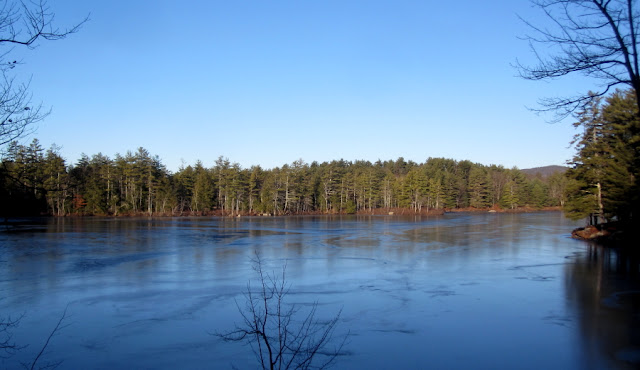Heading out into the woods on the morning after the first snow of the season always raises my curiosity as to what I'll discover has been out walking around the forest without my knowledge. Add the forgotten beauty of what winter in New Hampshire brings to the landscape, and it's a highly anticipated moment.
I expect to see tracks of the common forest animals: squirrel, fox, deer, perhaps coyote or turkey. Less likely to be found are tracks of bobcat, fisher, mink, or weasel - I'm lucky to see these just a few times over the winter. Sometimes if snow comes early enough in the year I'll find bear tracks, but probably not in mid-December unless it's been unusually warm. This year, the first snow-covered morning revealed mostly mice!
 |
| A long trail of a mouse hopping across the snow. |
Their tiny feet left clear tracks in the thin layer of snow.
The tell-tale drag of their tail indicates its a mouse rather than a vole which has a shorter tail.
Mice, having a prodigious breeding rate, are the primary food source for many winter predators so it's no surprise that their tracks most often take a bee-line from one hiding spot to another but occasionally there is a zig or a zag.
 |
| A quick change in direction. |
Note also the change in speed of its travel as shown by the increased distance between hops; perhaps something startled it and it dashed to its nearest hole.
It's amazing how many mice burrows there are throughout the forest, completely unnoticed except when there's thin layer of snow on the ground. They like to have their entrance holes protected so they can peek out to make sure no one is lurking behind them, ready to pounce upon them as they exit.
 |
| Safely guarded on the rear by a tree. |
 |
| Or under a log. |
 |
| This one has two small trees standing guard. |
Later in the winter when the snow gets deeper they won't ever expose themselves. Instead they'll excavate a network of tunnels under the snow that connects their dens to their food stores. I won't see them, but the foxes will locate them with their incredible hearing and know just where to pounce down through the snow to catch them as they travel their hidden network.
But on this morning, among all those mice and squirrel tracks, where were the fox? I didn't a single track. As the light of day grew brighter I saw the fox had also been out, but it was on the lake - which couldn't have had more than an inch of ice on it at that point in time. With a weight only around a dozen pounds distributed over four paws they don't need much ice to make it worth taking a shortcut across the lake from home to hunting grounds. We often get to see a fox on the lake at least once a year so that's something else to anticipate now that the lake is frozen.
And frozen it is - almost. On windy December 7th there was still lots of blue water.
But by this morning there was a beautiful sheet of smooth ice on the lake.
 |
| December 12th |




Thanks for a very informative snd interesting post.
ReplyDelete